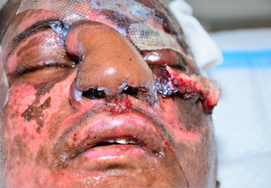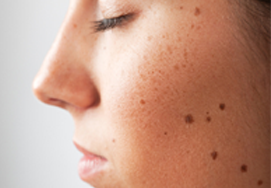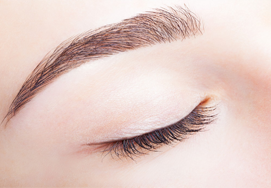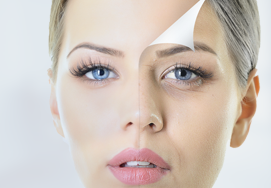Face Lift or Rhytidectomy
Suitable for patients with sagging skin in the midface and jawline, deep creases extending from your nose to the corners of your mouth (nasolabial folds), lines extending from each corner of your mouth down your chin (marionette lines), and facial fat (volume) that has fallen or is displaced

- What is Facelift?
- Why Have a Facelift?
- What are the types of facelift surgeries?
- Which individuals are suitable for the surgery?
- Can a Facelift Improve My Eyelids Too?
- How should I prepare for the surgery?
- What happens during the surgery?
- What happens during the surgery?
- What are the postsurgical considerations?
What is Facelift?
Aging may cause changes in the face such as formation of wrinkles and sagging skin. The folding on the skin masks the vitality that you feel inside. All these can be reversed through face lift.
A facelift or rhytidectomy is a cosmetic surgical procedure that reduces, sagging and wrinkling of skin on your face and neck. As you age, the elasticity and gravity of the skin and soft tissues decreases. Aging also involves the formation of deep lines below the lower eyelid and also between the mouth and nose which creates a tired, older appearance. The surgery involves reshaping the bottom one-third of the face by removing the excess skin. It also makes you feel great and look younger.
Why Have a Facelift?
As we age, skin begins to lose elasticity, and facial tissues lose volume. Eventually, this results in “jowls” on the lower face, deep wrinkles, and loose skin on the neck. While this is a natural part of growing older, patients who are bothered by these signs of aging may find a facelift to be a good solution. If any of the following describe you, a facelift is an option to consider:
- You feel self-conscious about the way your face & neck look due to sagging skin
- You wear turtlenecks and scarves not because you want to, but because you want to hide your aging neck
- When you see your reflection, you feel that your face makes you look much older than you feel
- You feel that an aging appearance is negatively affecting your career or personal relationships
Following a facelift, patients frequently experience an upsurge in self-confidence, as their appearance better portrays their healthy, energetic vibe.
What are the types of facelift surgeries?
There are different types of facelifts that you can choose based on your preferences regarding downtime and the recovery and also your facial anatomy. The types of surgeries vary depending on the type of incision, the number of tissues involved, the area of the face to be targeted, and the extent of invasiveness.
The different types of facelifts are listed below:
- Deep plane lift: The deep plane lift is an invasive process and is considered as a gold standard. The procedure involves reshaping your whole face.
- Short scar facelift: The short scar facelift is also known as S-Lift, MACS Lift or Minimal Incision Facelift. The S-lift involves an S-shaped incision at the temple or in front of your ear. This type of facelift limits the incision before the ear.
- Endoscopic facelift: The endoscopic facelift is a less invasive procedure. It is an outpatient procedure performed using local or intravenous anesthesia.
- Midface lift: The midface lift or cheek lift targets the area that begins below the eye to the lower cheek. This procedure improves nose-to-mouth lines and lifts sagging cheeks.
Which individuals are suitable for the surgery?
You can undergo a facelift surgery if:
- You feel that your face does not reflect the youthful spirit and the energy level
- You show the signs of facial aging but also have some skin elasticity
The characteristics that make you an appropriate candidate for the facelift are listed below:
- Sagging skin in your midface and jawline
- Deep creases extending from your nose to the corners of your mouth (nasolabial folds)
- Lines extending from each corner of your mouth down your chin (marionette lines)
- Facial fat (volume) that has fallen or is displaced
- Sagging and loss of muscle tone in the lower face, resulting in jowls
- A double chin, resulting from loose skin and excess fatty deposits under the chin and jaw
- Creased and sagging skin in your neck
Can a Facelift Improve My Eyelids Too?
It’s not uncommon to hear the word “facelift” used when referring to any type of facial rejuvenation surgery, and understandably, a lot of people think that a facelift involves operating on the entire face—eyes, brow, cheeks and chin. That’s understandable; after all, your eyes and forehead are part of your face too. However, a facelift on its own only addresses the lower two thirds of the face – the cheeks and jawline.
It is common for patients to choose to have an eyelid lift, brow lift or neck contouring at the same time as a facelift, but in these cases, a cosmetic surgeon will actually be performing two different procedures in one single operation. Likewise, patients who only want to address aging around the eyes or neck can typically achieve their goals with only an eyelid lift or neck lift, and not a facelift.
How should I prepare for the surgery?
Preparing for your facelift procedure will include an appointment with your plastic surgeon about your health and lifestyle. The surgeon will review your medical history and evaluate your general health status. Before the facelift surgery, you surgeon will likely:
- Discuss the reason why you want the surgery and your expectation with the surgeon.
- Perform a physical examination and examine your facial skin, facial bone structure and neck.
- Ask you to avoid certain medications such as aspirin, and other anti-inflammatory drugs and herbal supplements that may increase the risk of bleeding during the surgery.
- Discuss the treatment options available.
- Give you instructions about the dietary requirements before undergoing the surgery.
- Advise you to stop smoking 1 or 2 weeks before the surgery.
What happens during the surgery?
The facelift procedure is individualized as per your needs. The facelift procedures may range from simple, minimally invasive techniques to more extensive face and neck lift procedures. The methods include traditional facelift and SMAS (superficial musculoaponeurotic system) lift.
A traditional facelift involves correcting the midface, jowls, and the neck and also removing the excess skin. A general anesthesia and intravenous sedation will be given. An incision will be made in the front of the ear that extends behind the ear. Then the underlying tissue is tightened, and the excess skin and fat from the lower face and neck is removed.
The SMAS (superficial musculoaponeurotic system) lift involves elevating the skin and also the deeper layers of the face and the neck. Your surgeon makes a minimal incision in front of the ear raises the SMAS and tightens the skin. The surgery lasts for about several hours. SMAS lift is the modern facelift technique. Your surgeon sutures or uses skin adhesives to close the incisions.
What should be the aftercare of the surgery?
You may take 4 hours to several weeks to recover following the procedure. Recovery from traditional facelift procedures may be lengthier than minimally invasive surgery. After the procedure, you should:
- Rest keeping your head elevated
- Avoid exposing your incisions to excess pressure or motion
- Avoid wearing the clothes that need to be placed over your neck
- Take the medication as recommended by your physician
- Ask your surgeon regarding when to resume the daily activities such as washing the hair, etc.
- Avoid sun exposure until your scars are no longer pink.
What are the postsurgical considerations?
You may experience post-surgical swelling and bruising that lasts for about two to three weeks. The risks involved with the facelift procedure are the following:
- Unfavorable scarring
- Bleeding (hematoma)
- Infection
- Poor wound healing
- Anesthesia risks
- Correctable hair loss at the incisions
- Facial nerve injury with weakness
- Facial asymmetry
- Skin loss
- Numbness or other changes in skin sensation
- Fluid accumulation
- Pain, which may persist
- Skin discoloration, sensitivity or swelling
- Sutures may produce irritation
- Possibility of revisional surgery













